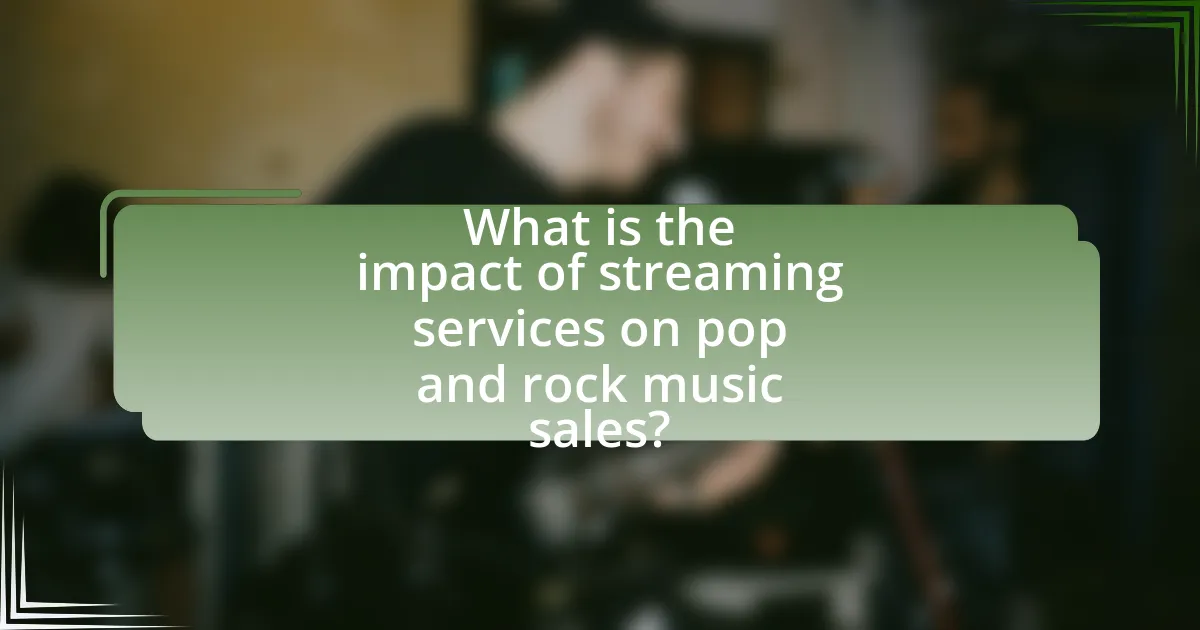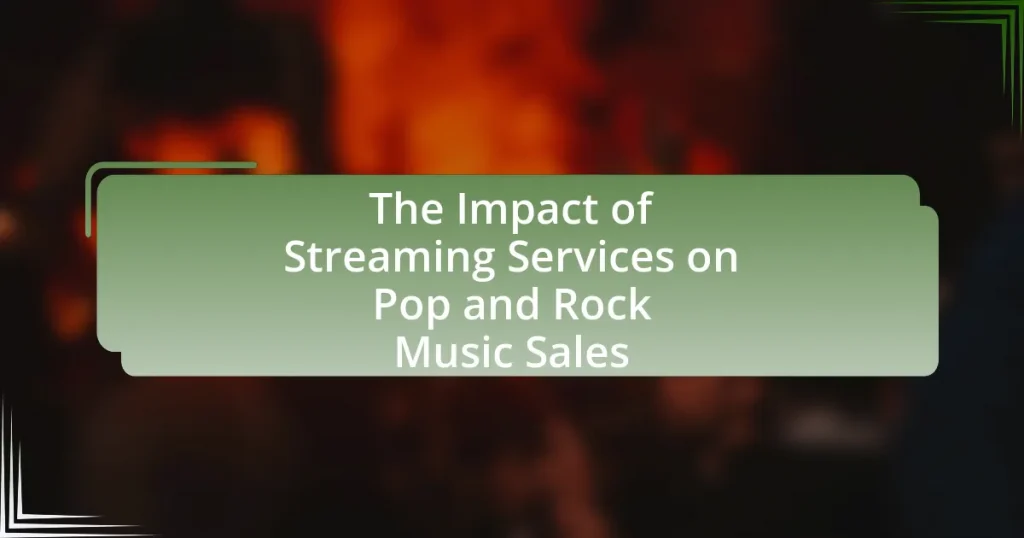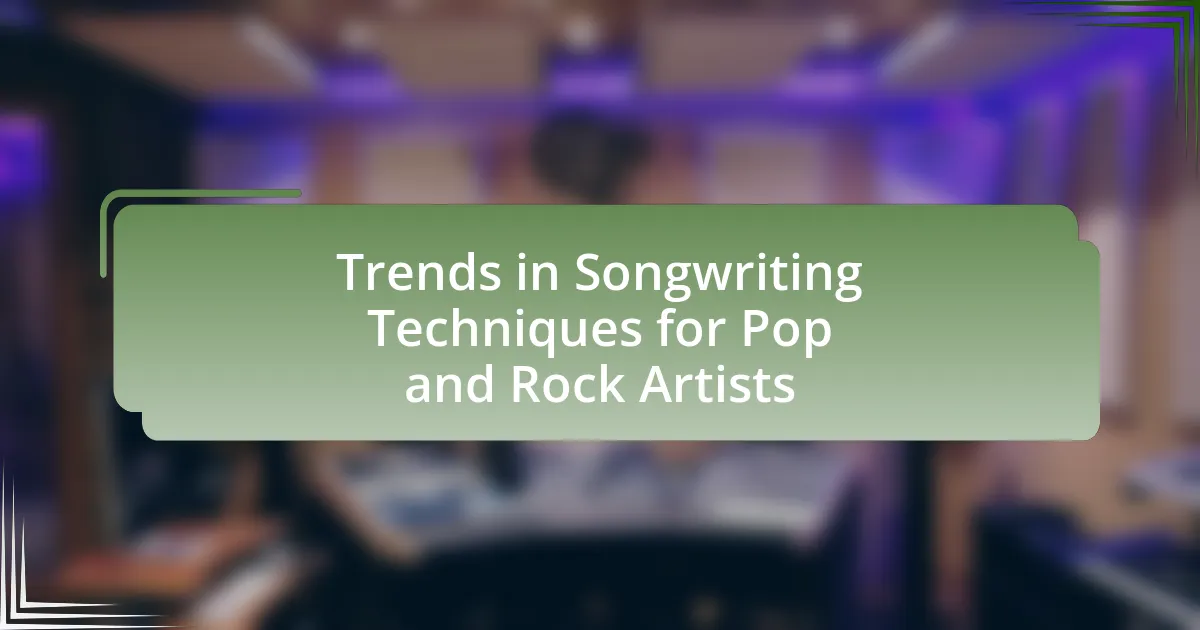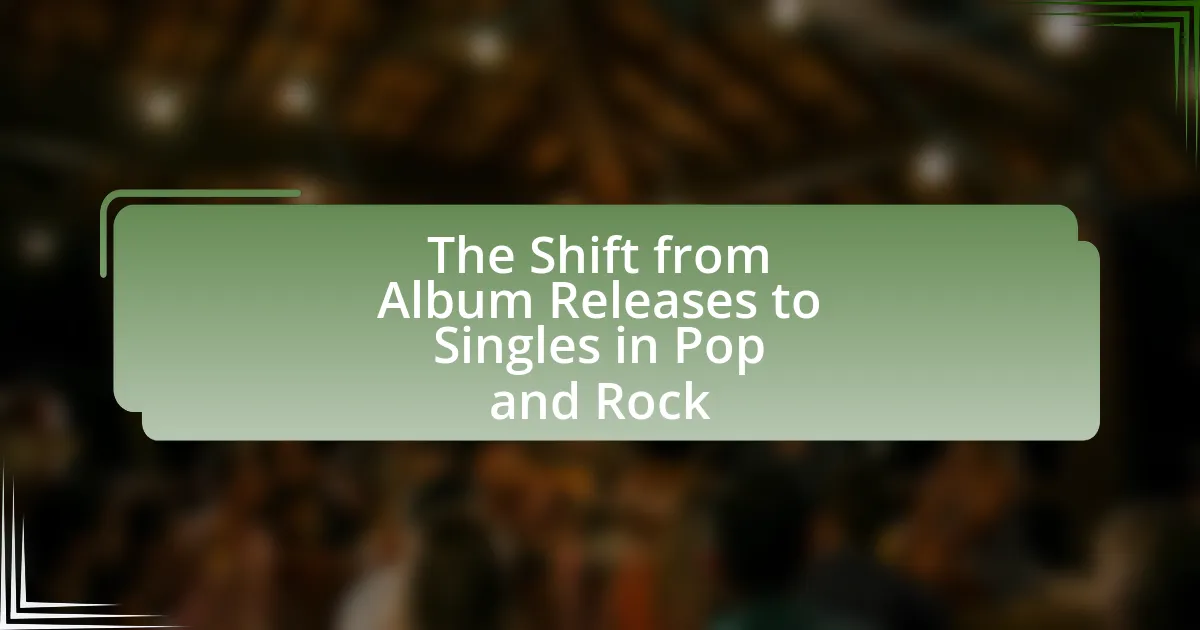The article examines the impact of streaming services on pop and rock music sales, highlighting a significant decline in traditional sales as streaming revenue surged past $10 billion in 2020. It discusses how streaming has transformed music consumption, emphasizing accessibility, personalized recommendations, and social sharing as key features influencing listener behavior. The article also explores demographic trends affecting streaming, the challenges artists face in a saturated market, and strategies for success in the streaming era. Additionally, it addresses the economic implications of streaming royalties compared to traditional sales and anticipates future trends in the music industry.

What is the impact of streaming services on pop and rock music sales?
Streaming services have significantly decreased pop and rock music sales. According to the Recording Industry Association of America (RIAA), U.S. recorded music revenue from streaming surpassed $10 billion in 2020, while physical sales and digital downloads have continued to decline, with physical sales dropping by 23% in the same year. This shift indicates that consumers are increasingly favoring streaming over purchasing music, leading to a reduction in traditional sales for pop and rock genres. Additionally, a report by Nielsen Music found that streaming accounted for 83% of all music consumption in the U.S. in 2021, further illustrating the dominance of streaming services in the music industry.
How have streaming services changed the music consumption landscape?
Streaming services have fundamentally transformed the music consumption landscape by shifting the focus from physical sales and downloads to on-demand streaming. This change has led to a significant increase in music accessibility, allowing users to listen to vast libraries of songs without purchasing individual tracks or albums. According to the Recording Industry Association of America (RIAA), streaming accounted for 83% of the U.S. music industry’s revenue in 2020, highlighting its dominance over traditional formats. Additionally, platforms like Spotify and Apple Music have enabled personalized playlists and algorithm-driven recommendations, enhancing user engagement and discovery of new music. This shift has not only altered consumer behavior but also impacted how artists release music, with many opting for singles and EPs to maintain visibility in a rapidly changing environment.
What are the key features of streaming services that influence music sales?
Key features of streaming services that influence music sales include accessibility, personalized recommendations, and social sharing capabilities. Accessibility allows users to easily access vast music libraries, which increases exposure for artists and can lead to higher sales. Personalized recommendations, driven by algorithms, help listeners discover new music tailored to their tastes, often resulting in increased purchases of songs or albums. Social sharing capabilities enable users to share their favorite tracks and playlists, creating organic promotion that can boost sales. According to a report by the Recording Industry Association of America (RIAA), the rise of streaming has significantly impacted music consumption patterns, leading to a 13% increase in overall music revenue in 2021, demonstrating the direct correlation between these features and music sales.
How do streaming platforms differ from traditional music sales methods?
Streaming platforms differ from traditional music sales methods primarily in their consumption model; streaming allows users to access a vast library of music for a subscription fee or for free with ads, while traditional sales involve purchasing individual songs or albums outright. This shift has led to a significant change in revenue generation, as streaming services like Spotify and Apple Music pay artists based on the number of streams rather than per sale, which has resulted in a decline in physical album sales and digital downloads. According to the Recording Industry Association of America (RIAA), streaming accounted for 83% of the U.S. music industry’s revenue in 2020, highlighting the dominance of this model over traditional sales methods.
Why are pop and rock genres particularly affected by streaming services?
Pop and rock genres are particularly affected by streaming services due to their reliance on mass appeal and the accessibility of music. Streaming platforms like Spotify and Apple Music have transformed how listeners discover and consume music, favoring popular tracks that can quickly gain traction through playlists and algorithmic recommendations. According to a report by the Recording Industry Association of America (RIAA), streaming accounted for 83% of the music industry’s revenue in 2020, highlighting the dominance of this model in shaping listener habits. Furthermore, pop and rock artists often benefit from viral trends on social media, which are amplified by streaming services, leading to increased exposure and sales. This dynamic creates a feedback loop where the most streamed songs dominate charts, further influencing listener preferences and industry investments.
What demographic trends influence pop and rock music streaming?
Demographic trends influencing pop and rock music streaming include age, gender, and geographic location. Younger audiences, particularly those aged 18-34, dominate streaming platforms, accounting for over 50% of total streams, as they prefer digital access over physical media. Gender also plays a role, with female listeners showing a higher engagement with pop music, while male listeners tend to favor rock genres. Additionally, geographic trends reveal that urban areas exhibit higher streaming rates compared to rural regions, driven by better internet access and a greater concentration of music events. These trends are supported by data from the Recording Industry Association of America, which highlights the shift in music consumption patterns among different demographic groups.
How do pop and rock artists adapt to the streaming model?
Pop and rock artists adapt to the streaming model by focusing on single releases and engaging with fans through social media. This shift allows artists to maintain visibility and relevance in a landscape where playlists and algorithms dictate exposure. For instance, the rise of platforms like Spotify has led to a significant increase in the consumption of singles over full albums, with data showing that over 60% of music streams come from playlists. Additionally, artists leverage social media to promote their music directly to fans, fostering a community that can drive streaming numbers. This adaptation is crucial as it aligns with the consumption habits of listeners who prefer on-demand access to music.
What are the economic implications of streaming services on music sales?
Streaming services have significantly reduced traditional music sales, leading to a decline in physical album purchases and digital downloads. According to the Recording Industry Association of America (RIAA), U.S. recorded music revenues from streaming surpassed $10 billion in 2020, while physical sales dropped to approximately $1 billion. This shift indicates that consumers are increasingly favoring subscription models over purchasing individual songs or albums, which alters revenue streams for artists and labels. Additionally, the payout structure of streaming services often results in lower per-stream earnings for musicians compared to traditional sales, impacting their overall income.
How do streaming royalties compare to traditional sales revenue?
Streaming royalties generally yield lower revenue per play compared to traditional sales revenue from physical or digital album purchases. For instance, a single stream on platforms like Spotify typically generates between $0.003 and $0.005, while a digital album sale can earn an artist around $9.99 to $12.99 per sale. This stark difference illustrates that artists need millions of streams to match the income from just a few album sales. According to a 2021 report by the Recording Industry Association of America (RIAA), streaming accounted for 83% of the U.S. music industry’s revenue, yet the per-stream payout remains significantly lower than the revenue generated from traditional sales.
What impact do streaming services have on album sales versus single sales?
Streaming services have significantly reduced album sales while increasing single sales. The convenience and accessibility of platforms like Spotify and Apple Music encourage listeners to stream individual tracks rather than purchase entire albums. According to the Recording Industry Association of America (RIAA), in 2020, digital single sales accounted for 80% of total digital music revenue, while album sales continued to decline, dropping by 23% from the previous year. This trend indicates that streaming services have shifted consumer behavior towards favoring singles over albums, fundamentally altering the music sales landscape.
How do streaming services affect artist exposure and discovery?
Streaming services significantly enhance artist exposure and discovery by providing a platform that reaches millions of listeners globally. These platforms utilize algorithms that recommend music based on user preferences, which increases the likelihood of new artists being discovered by audiences who may not have encountered them otherwise. For instance, Spotify’s Discover Weekly feature has been credited with boosting the visibility of emerging artists, leading to a 30% increase in streams for those featured. Additionally, streaming services often curate playlists that highlight new music, further facilitating artist exposure. According to a report by the International Federation of the Phonographic Industry (IFPI), 70% of users discover new music through streaming services, underscoring their role in artist discovery.
What role do playlists play in promoting pop and rock music?
Playlists play a crucial role in promoting pop and rock music by increasing visibility and accessibility for artists. Streaming platforms like Spotify and Apple Music curate playlists that feature trending songs, which can significantly boost an artist’s streams and audience reach. For instance, being included in a popular playlist can lead to a substantial increase in monthly listeners; Spotify reported that tracks featured on their “Today’s Top Hits” playlist can see a 300% increase in streams. This exposure not only helps established artists maintain their popularity but also allows emerging artists to gain traction in a competitive market.
How do algorithms influence listener engagement with pop and rock artists?
Algorithms significantly influence listener engagement with pop and rock artists by personalizing music recommendations and enhancing discoverability. Streaming platforms like Spotify and Apple Music utilize algorithms that analyze user behavior, such as listening history and preferences, to curate playlists and suggest new tracks. This tailored approach increases the likelihood of listeners engaging with specific artists, as evidenced by a study from the University of Southern California, which found that algorithm-driven playlists can boost an artist’s streams by up to 30%. Consequently, algorithms not only shape individual listening experiences but also impact overall trends in pop and rock music consumption.
What challenges do artists face in the streaming era?
Artists face significant challenges in the streaming era, primarily due to reduced revenue from music sales. Streaming platforms typically pay artists a fraction of a cent per stream, which leads to lower overall earnings compared to traditional album sales. For instance, a report from the Music Industry Revenue in 2021 indicated that artists earn approximately $0.003 to $0.005 per stream, making it difficult for many to sustain a living solely from their music. Additionally, the oversaturation of content on these platforms makes it challenging for individual artists to gain visibility and attract listeners, further complicating their ability to monetize their work effectively.
How does the oversaturation of content affect artist visibility?
The oversaturation of content significantly diminishes artist visibility by overwhelming audiences with choices, leading to decreased engagement with individual artists. As streaming services like Spotify and Apple Music host millions of tracks, listeners often struggle to discover new music, resulting in a phenomenon known as “choice paralysis.” According to a 2021 report by MIDiA Research, over 60% of listeners find it challenging to find new music due to the sheer volume of available content. This saturation not only makes it harder for emerging artists to stand out but also shifts listener attention towards established names, further marginalizing lesser-known talents.
What strategies can artists employ to succeed in a streaming-dominated market?
Artists can succeed in a streaming-dominated market by leveraging data analytics, engaging with fans on social media, and collaborating with other artists. Data analytics allows artists to understand listener preferences and optimize their release strategies, as evidenced by platforms like Spotify providing insights into audience demographics and listening habits. Engaging with fans on social media fosters a loyal community, which is crucial for driving streams and promoting new releases; studies show that artists with active social media presence see higher engagement and streaming numbers. Collaborating with other artists can expand reach and introduce music to new audiences, as seen in successful partnerships that have led to viral hits.
What future trends can we expect in streaming services and music sales?
Future trends in streaming services and music sales indicate a continued shift towards subscription-based models and increased integration of artificial intelligence. Streaming platforms are expected to enhance user personalization through AI algorithms, which will drive engagement and retention. According to a report by the International Federation of the Phonographic Industry (IFPI), global recorded music revenues grew by 7.4% in 2021, largely due to the rise of streaming subscriptions, which accounted for 65% of total revenues. Additionally, the emergence of high-fidelity audio formats and exclusive content offerings will likely attract more listeners, further boosting sales. As of 2023, the trend towards bundling services with other digital offerings, such as gaming and video streaming, is also anticipated to expand, creating a more comprehensive entertainment ecosystem.
How might emerging technologies reshape the streaming landscape?
Emerging technologies will reshape the streaming landscape by enhancing user experience through improved algorithms, augmented reality, and artificial intelligence. These advancements enable personalized content recommendations, making it easier for users to discover new music tailored to their preferences. For instance, AI-driven analytics can analyze listening habits and suggest songs or artists that align with individual tastes, significantly increasing user engagement. Additionally, augmented reality can create immersive experiences for live performances, allowing fans to interact with artists in innovative ways. According to a report by Deloitte, 80% of consumers are more likely to engage with platforms that offer personalized experiences, highlighting the importance of these technologies in shaping future streaming services.
What potential changes in consumer behavior could impact pop and rock music sales?
Potential changes in consumer behavior that could impact pop and rock music sales include a shift towards streaming over physical purchases and a preference for curated playlists. As consumers increasingly favor platforms like Spotify and Apple Music, traditional album sales decline; for instance, the Recording Industry Association of America reported a 23% drop in physical album sales from 2019 to 2020. Additionally, the rise of social media influences music discovery, with platforms like TikTok driving trends and impacting which songs gain popularity, further affecting sales dynamics.
What best practices can artists follow to maximize their success on streaming platforms?
Artists can maximize their success on streaming platforms by consistently releasing high-quality music, engaging with their audience, and utilizing data analytics. Regularly releasing new music keeps listeners engaged and can improve algorithmic placements on platforms like Spotify and Apple Music. Engaging with fans through social media and live performances fosters a loyal fanbase, which can lead to increased streams and shares. Utilizing data analytics helps artists understand listener demographics and preferences, allowing for targeted marketing strategies. According to a report by MIDiA Research, artists who actively engage with their audience see a 30% increase in streaming numbers compared to those who do not.




